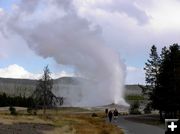

Old Faithful
Old Faithful geyser at Yellowstone National Park attracts millions of people a year. Pinedale Online file photo.
|
|
How should National Parks be managed?
Public comment period open until January 19, 2006
October 19, 2005
The National Park Service (NPS) is proposing to update the policies that guide the management of the national park system. The policies are being updated to improve their clarity and to keep pace with changes in laws, regulations, socio-economic factors and technology. The policies will determine how decisions are made in protecting park resources and providing opportunities for the public to enjoy the parks.
There is a 90-day public comment period from October 19, 2005 until January 19, 2006. The Draft Management Policies are available for review online on the National Park Service website (see related links below).
The 1970 National Park System General Authorities Act, as amended in 1978, prohibits the Service from allowing any activities that would cause derogation of the values and purposes for which the parks have been established (except as directly and specifically provided by Congress). Taken together, these two laws require NPS managers to manage the amount, kind, time, and place of park uses in such a way that future generations can enjoy park resources and values, and appreciate their national significance in as good or better condition than the generation that preceded them. What exactly that all means in terms of actual uses, is at the heart of many of the debates between environmentalists who want to minimize manís impact on public lands and special interest groups who want access to public land for recreational purposes.
The revised Draft Management Policies document covers appropriate uses and unacceptable impacts, wildlife stewardship, park system planning, land protection, education and interpretation; recreational use, river and backcountry use, fishing, hunting and trapping; motorized use for roads, off-trail, snowmobiles and watercraft; handicap accessibility; visitor safety and emergency services; commercial services and uses; fees; law enforcement; overflight and aviation uses; Native American uses: utility right of ways; special uses; filming and photography; agricultural uses and grazing; cemeteries, burials and scattering of ashes; mining claims and federal mining leases, and other park management topics.
Related Links:
Draft Management Policies (National Park Service)
|
